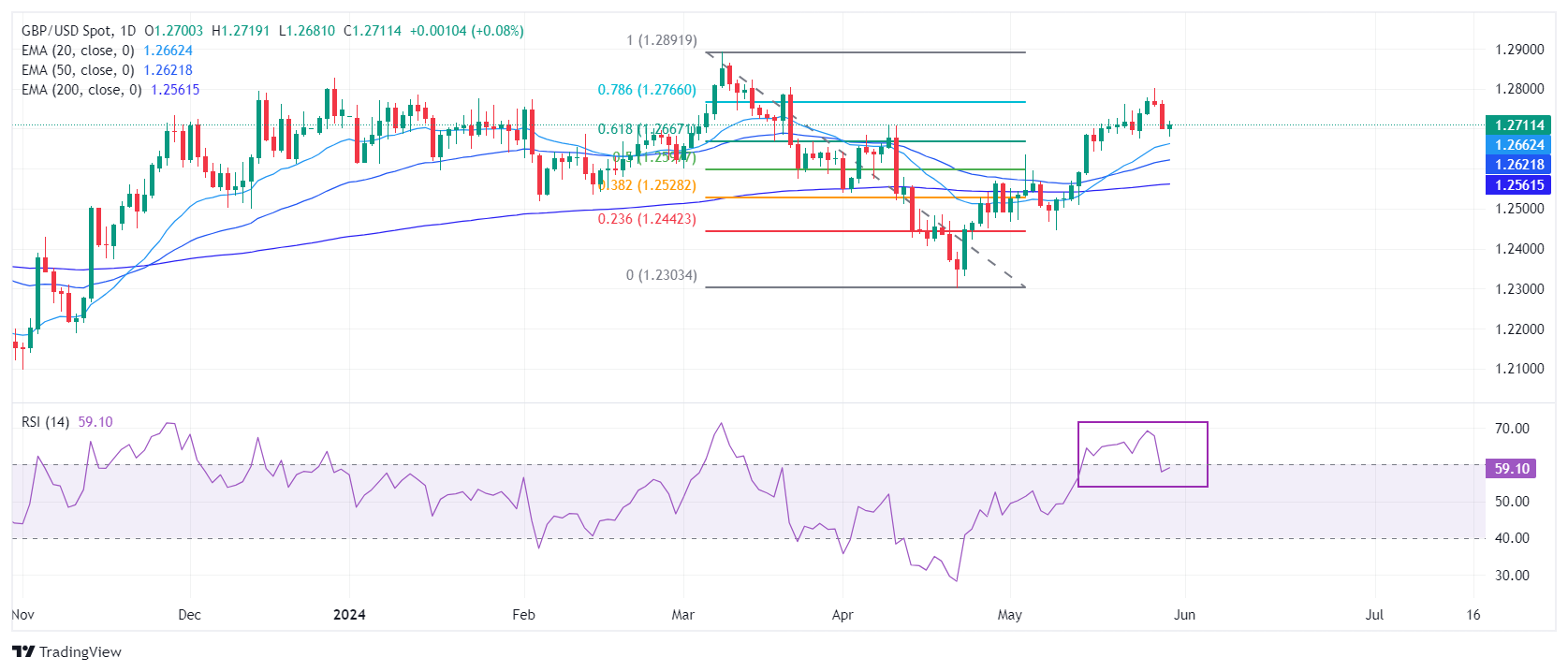- British Pound Finds Support Below 1.2700 Despite Uncertainty Ahead of US Core PCE Inflation Data
- High services inflation in the UK remains a barrier to the sustainable return of price pressures towards the 2% target.
- Traders reduce Fed rate cut expectations for September due to persistent inflation outlook.
The British Pound (GBP) finds support below the round figure of 1.2700 against the US Dollar (USD) in the American session on Thursday. The US dollar fell sharply after the US Bureau of Labor Statistics (BLS) reported that the economy grew at a slower pace of 1.3% according to the revised estimate, compared to the preliminary reading of 1.6%. This has weighed on the US dollar. The US Dollar Index (DXY), which tracks the value of the USD against six major currencies, fell further to 104.70.
Separately, the US Department of Labor reported initial jobless claims data for the week ending May 24. First-time filers for unemployment benefits were 219,000, higher than estimates of 218,000 and the previous reading of 216,000, revised up from 215,000.
However, the near-term outlook for the GBP/USD pair remains uncertain due to cautious market sentiment ahead of the US Core Personal Consumption Expenditure (PCE) Price Index data for April, which is due to be released. on Friday.
The British pound will rarely be influenced by market speculation over the Bank of England's (BoE) interest rate cuts, which financial markets expect to begin at the August meeting. At the beginning of the year, investors anticipated that the BoE would begin reducing key interest rates in June. However, investors are dialing down rate cut expectations for June after the UK consumer price index (CPI) report for April showed price pressures slowing at a slower pace than estimated.
Although the UK's headline CPI has fallen significantly, BoE policymakers are still concerned about a sharp slowdown in the momentum of services inflation, which is almost double the pace needed to bring core inflation back to the target. 2%.
Daily Moves and Market Drivers: British Pound Recovers as US Dollar Corrects Further
- The British Pound finds support near 1.2700 amid a focus on US Core PCE Price Index data for April, due out on Friday. The annual and monthly readings of core PCE inflation are estimated to have grown steadily by 2.8% and 0.3%, respectively.
- Investors will focus intensely on the US Federal Reserve's (Fed) preferred inflation gauge as it will significantly influence speculation about Fed rate cuts at the September meeting. The CME FedWatch tool shows that the probability that interest rates will be lower than current levels in September has dropped to 47% from last week's reading of 51%. Traders lower expectations for Fed rate cuts for September after the US conference board showed on Tuesday that consumer confidence for May improved surprisingly and the preliminary S&P Global PMI report for May beat expectations. expectations.
- US Consumer Confidence rose to 102.00 from 97.5 in April after deteriorating consecutively for three months. The consumer confidence report, which publishes the current situation index and the expectations index that reflects the current and near-term outlook, respectively, of labor and business market conditions, surpassed its previous readings.
- The Fed's hawkish guidance on interest rates has also weighed on expectations for Fed rate cuts. Monetary policymakers want to see inflation slow for months before leaning toward the normalization process. about politic. Officials maintained a hardline stance despite a slowdown in price pressures in April. They argued that a one-time decline in inflation is insufficient to have confidence that progress in the disinflation process has resumed after stalling throughout the first quarter.
Technical Analysis: Sterling appears well supported near 61.8% Fibonacci retracement around 1.2670
The British Pound finds temporary support slightly below 1.2700 in the European session on Thursday after heavy selling on Wednesday. The short-term outlook for the GBP/USD pair remains bullish as it holds the 61.8% Fibonacci retracement support (drawn from the March 8 high of 1.2900 to the April 22 low of 1.2300) at 1.2670. The Pound is expected to remain bullish as all short-term to long-term exponential moving averages (EMAs) are tilted upwards, suggesting a strong bullish trend.
The 14-period RSI has fallen into the 40.00-60.00 range, suggesting that the momentum, which was leaning towards the upside, has moderated for now.
Economic Indicator
Annualized Gross Domestic Product
The real annualized Gross Domestic Product (GDP), published quarterly by the US Bureau of Economic Analysis, measures the value of final goods and services produced in the United States in a given time period. Changes in GDP are the most popular indicator of the nation's overall economic health. The data is expressed at an annualized rate, which means that the rate has been adjusted to reflect the amount that GDP would have changed in one year, if it had continued to grow at that specific rate. Generally speaking, a high reading is considered bullish for the US Dollar (USD), while a low reading is considered bearish.
The US Bureau of Economic Analysis (BEA) publishes Gross Domestic Product (GDP) growth on an annualized basis for each quarter. After publishing the first estimate, the BEA reviews the data two more times, with the third publication being the final reading. Typically, the first estimate moves the market the most and a positive surprise is considered a positive development for the USD, while a disappointing number will likely weigh on the dollar. Second and third releases are generally dismissed by market participants as they are generally not significant enough to significantly alter the growth picture.
Source: Fx Street
I am Joshua Winder, a senior-level journalist and editor at World Stock Market. I specialize in covering news related to the stock market and economic trends. With more than 8 years of experience in this field, I have become an expert in financial reporting.








